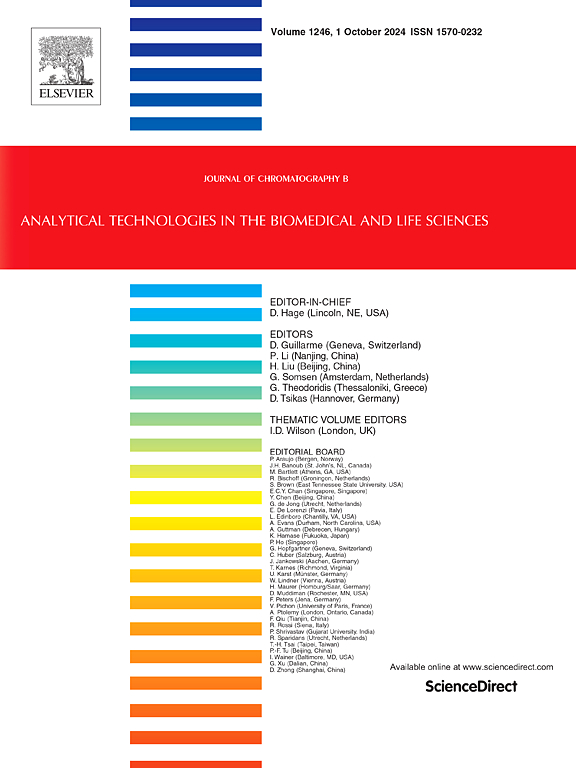开发成像毛细管等电聚焦技术,作为基于非对称武溪体的双特异性抗体的平台误配对副产物检测方法
IF 2.8
3区 医学
Q2 BIOCHEMICAL RESEARCH METHODS
引用次数: 0
摘要
本研究探索了成像毛细管等电聚焦(icIEF)技术在基于不对称乌希抗体的双特异性抗体(AsWXbsAbs)中的应用,以区分和量化配对错误的副产物。使用Knobs-into-Holes(KiH)技术开发的双特异性抗体(BsAb)通常会产生副产物,如与目标BsAb大小相似的knob-knob(KK)和hole-hole(HH)同源二聚体,从而使传统的尺寸排阻色谱-高效液相色谱(SEC-HPLC)等方法分离它们变得复杂。我们的方法利用了 AsWXbsAbs 中用 T 细胞受体(TCR)恒定结构域取代 CH1/CL 结构域所带来的独特 pI 差异。这种修改使 icIEF 能够有效区分 KK 和 HH 同源二聚体和目标 BsAb。通过构建和表达重链和轻链变体,我们验证了实验 pI 值与理论预测值一致,证实了 icIEF 区分这些实体的能力。我们实现了过程中 K 相关和 H 相关物种的富集,从而获得了开发 icIEF 方法所需的高纯度样本。经鉴定,该方法具有良好的特异性和线性,K 相关物种的定量限为 4%(R2 = 0.9919),H 相关物种的定量限为 1%(R2 = 0.9805)。该方法被有效地用作过程中测试和释放检测,证明了其在多个 AsWXbsAbs 项目中简单快捷的实用性。本文章由计算机程序翻译,如有差异,请以英文原文为准。
Development of imaged capillary isoelectric focusing as a platform mispairing byproduct testing method for asymmetric WuXiBody-based bispecific antibodies
This study explores the application of imaged capillary isoelectric focusing (icIEF) to distinguish and quantify mispairing byproducts in asymmetric WuXiBody-based bispecific antibodies (AsWXbsAbs). Bispecific antibody (BsAb), developed using Knobs-into-Holes (KiH) technology, often result in byproducts such as knob-knob (KK) and hole-hole (HH) homodimers, which share similar sizes with the target BsAb, complicating their separation by traditional methods like size exclusion chromatography-high performance liquid chromatography (SEC-HPLC). Our approach leverages the unique pI differences introduced by substituting the CH1/CL domain with the T cell receptor (TCR) constant domain in AsWXbsAbs. This modification enables icIEF to effectively differentiate between the KK and HH homodimers and the target BsAb. Through the construction and expression of heavy and light chain variants, we validated that the experimental pI values aligned with theoretical predictions, confirming icIEF’s capability in distinguishing these entities. Enrichment of in-process K-related and H-related species was achieved, allowing for high-purity samples necessary for icIEF method development. The method was qualified and showed good specificity and linearity, with a quantitation limit of 4 % for K-related species (R2 = 0.9919) and 1 % for H-related species (R2 = 0.9805). This method was used effectively as an in-process test and release assay, proving its simple and quick utility in multiple AsWXbsAbs projects.
求助全文
通过发布文献求助,成功后即可免费获取论文全文。
去求助
来源期刊

Journal of Chromatography B
医学-分析化学
CiteScore
5.60
自引率
3.30%
发文量
306
审稿时长
44 days
期刊介绍:
The Journal of Chromatography B publishes papers on developments in separation science relevant to biology and biomedical research including both fundamental advances and applications. Analytical techniques which may be considered include the various facets of chromatography, electrophoresis and related methods, affinity and immunoaffinity-based methodologies, hyphenated and other multi-dimensional techniques, and microanalytical approaches. The journal also considers articles reporting developments in sample preparation, detection techniques including mass spectrometry, and data handling and analysis.
Developments related to preparative separations for the isolation and purification of components of biological systems may be published, including chromatographic and electrophoretic methods, affinity separations, field flow fractionation and other preparative approaches.
Applications to the analysis of biological systems and samples will be considered when the analytical science contains a significant element of novelty, e.g. a new approach to the separation of a compound, novel combination of analytical techniques, or significantly improved analytical performance.
 求助内容:
求助内容: 应助结果提醒方式:
应助结果提醒方式:


